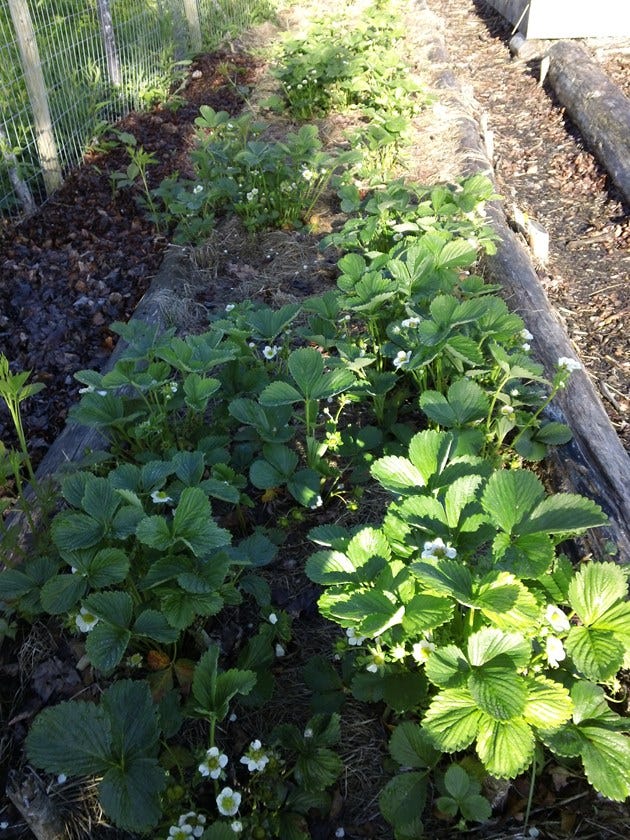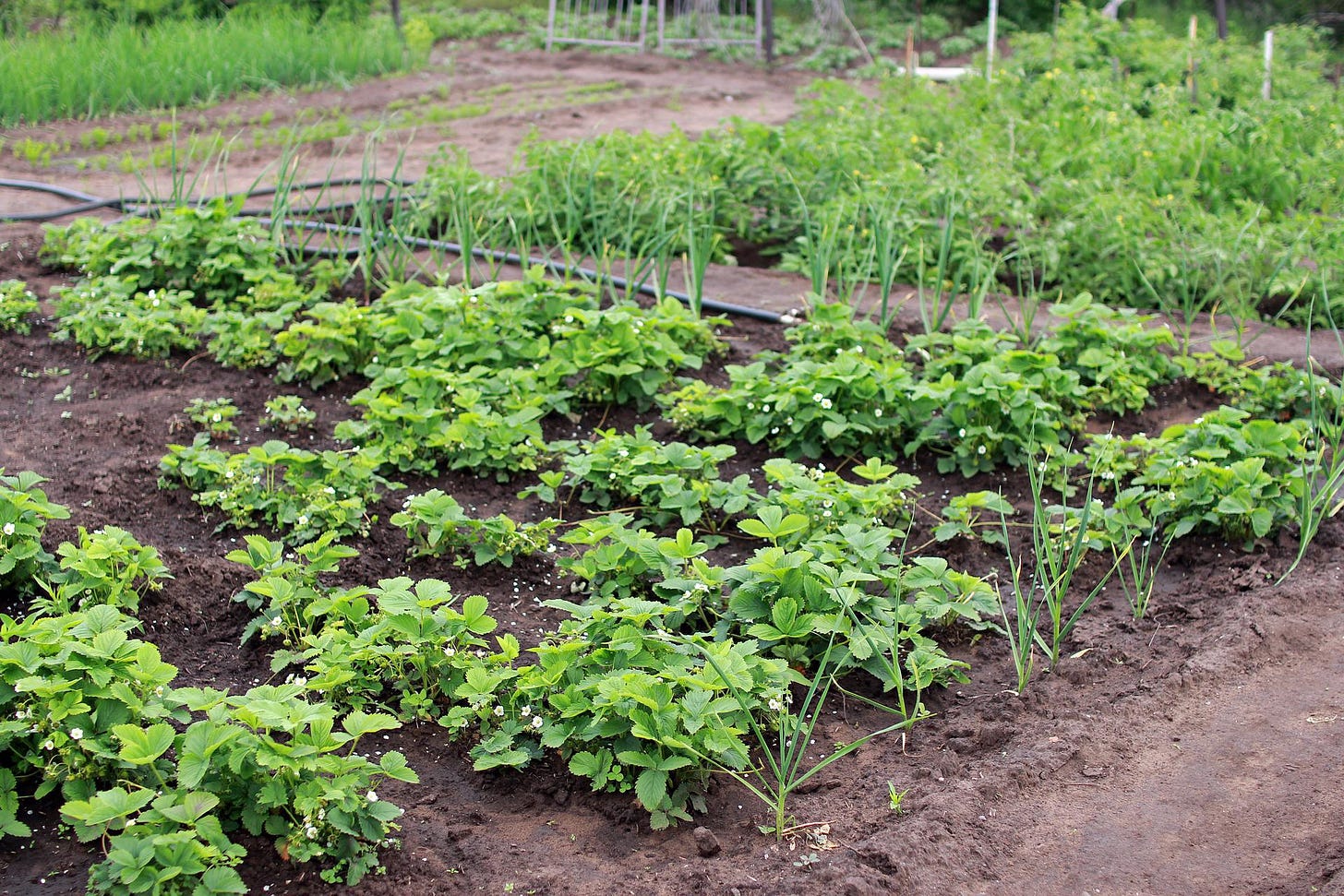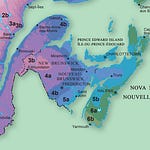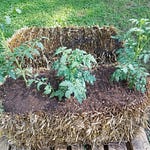I have no idea why, but for some reason, the strawberry is not the most popular plant in the world among food gardeners. People prize their peppers, tout their tomatoes, and covet their corn, but little to nothing is often said of strawberries — and this is crazy because the strawberry is one of the sweetest things you can grow in a northern climate, and is easier to grow than all the aforementioned by a landslide, and it's also a perennial!!!
This bed of strawberries was the result of a $10 purchase of bare-root plants — one the best returns on investment that I've ever experienced!
In the spring of 2013, for the first time ever, I bought a bucketful of bare-root strawberry plants and put them in my garden. Within a few months, I started getting a few fresh strawberries each day, and then in the fall I had a large harvest, from which I made delicious jam that we coveted jealously and shared with no one. I couldn't believe how easy it was to grow strawberries and I really kicked myself for not having tried them sooner. This year, if you have the space, try growing strawberries!
How to plant
Buy bare-root strawberry plants and get them in the ground about a month after the soil has become workable (right about now – when the dandelion flowers start turning yellow). They are usually sold in bundles of about 20 plants, and that many will easily fill a 4' X 10' bed or more. Plant them in a bed with fertile soil. To plant, dig down a
few inches, then spread the roots out horizontally, like a fan, not too deep (no deeper than four inches — it's too cold below that depth). Space them out in at least a 12” (30cm) grid, and then cover with soil. Once they are about three inches high, cover all the soil with a mulch. Straw is a good mulch, but anything will do. I have used woodchips, hay, straw, leaves and seaweed - all with good results.
This bed of strawberries is in serious need of a mulch! (https://pixabay.com/photos/country-house-vegetable-garden-2699712/)
I've heard they're a lot of work to maintain
Many people say they are a lot of work to maintain, but if you keep them mulched a lot of the work (weeding, watering, fertilizing) is taken care of by the mulch. All you need to do remove the runners when they emerge (unless you want more strawberry plants), and then cover everything with two to three inches of mulch at the end of the growing season (November-ish for me). The strong and healthy plants will push through the mulch in the spring while the older, weaker plants will die, disappear and fertilize the soil. Aside from this task, the only real chore is harvesting and eating them!
What are runners?
Runners (stolons) are clone plants that the existing strawberry plant propagates each year. Sometime in July/August, depending on the variety, the main plant sends out a tendril that travels about 12 inches, which then develops a bud and tries to send roots into the ground. The same tendril may even send out another length to establish another plant. These can be positioned to grow where you want, or they can be cut off (once the bud has created roots) and moved to create more strawberry gardens elsewhere. Strawberry plants are productive for about 3 or 5 years, and then they start to shut down – so in year 4 it makes sense to let the runner propagate so you will have new plants the following year. It’s also the case the the main plant is more productive when you remove the runners because it sends all its energy to the fruit rather than investing in its runners.
Varieties
The three main varieties of strawberry are: June-bearing; day-neutral; and, ever-bearing. June-bearers provide their whole yield in June. This variety is the heaviest yielding, but of course, it's a one-shot deal. Ever-bearing strawberries usually put out a good harvest in spring, and then another in the fall. Day-neutral strawberries give a good yield in spring and fall, but they also produce intermittently all summer long as long as it does not consistently stay above 27 C for too long. All three have their merits and I’ve grown them all. Personally, I prefer the June bearing variety because I’m primarily growing them to make jam, and in June there’s not much else to harvest in the garden, so it’s not overwhelming to have to pick and process them at that time of year, as opposed to in the fall, when the whole garden is producing buckets of food a day and I’m barely able to keep up with it. It’s also the case that with June-bearers, there is a shorter period of time where it’s necessary to protect the berries from birds, squirrels and chipmunks. It’s also nice to have something delicious so early in the growing season.
For my money freezer jam is the way to go where strawberries are concerned!
A note about jam
Strawberries are at their best when they are fresh. I am always surprised when I hear that people make cooked jam with their home-grown strawberries. I’m even more surprised when I hear that they have BOUGHT fresh strawberries and then made cooked jam with them – because everything that is good and wonderful about strawberries goes away when you apply heat. Sure, the sweetness remains, but the flavour changes dramatically. It’s also the case the freezer jam is easier to make, which is helpful when you have a couple flats of them to process! If you have not yet tried freezer jam, give it a whirl this season and you may find that you never go back to that other stuff!
Final thoughts
While fresh, garden strawberries differ significantly from store-bought varieties in terms of shelf life (they do not keep at all — harvest often and eat or preserve immediately), they knock it out of the park in the flavour department. In fact, you may never buy strawberries again once your strawberry beds are established and producing. For me, it's all about the flavour. Make this the year that you plant strawberries in your garden. You will not be sorry!
FREE SHIPPING FROM VESEYS SEEDS
Use my NEW coupon code “GAVS25” to get free shipping from Veseys Seeds on seed catalogue orders. Free shipping is not applicable on surcharges on larger items. Promo code is valid until November 30, 2025.

















Share this post